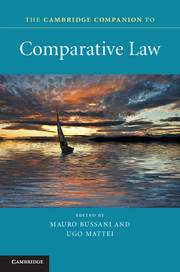Book contents
- Frontmatter
- Contents
- Contributors
- Abbreviations
- Preface
- Part I Knowing comparative law
- Part II Comparative law fields
- Part III Comparative law in the flux of civilizations
- 12 The East Asian legal tradition
- 13 The Jewish legal tradition
- 14 The Islamic legal tradition
- 15 The sub-Saharan legal tradition
- 16 The Latin American and Caribbean legal traditions
- 17 Mixed legal systems
- 18 Democracy and the Western legal tradition
- Index
13 - The Jewish legal tradition
Published online by Cambridge University Press: 05 May 2013
- Frontmatter
- Contents
- Contributors
- Abbreviations
- Preface
- Part I Knowing comparative law
- Part II Comparative law fields
- Part III Comparative law in the flux of civilizations
- 12 The East Asian legal tradition
- 13 The Jewish legal tradition
- 14 The Islamic legal tradition
- 15 The sub-Saharan legal tradition
- 16 The Latin American and Caribbean legal traditions
- 17 Mixed legal systems
- 18 Democracy and the Western legal tradition
- Index
Summary
The structure and sources of law in the Jewish tradition
Judaism is fundamentally a religion of law, a law that governs every facet of the human condition. Jewish tradition maintains that the Torah – the first five books of the Bible that include the Written Law transmitted by Moses at Mount Sinai as well as the Oral Law accompanying it – contains not merely a set of laws, but also canons of interpretation and principles according to which conflicts among the rules of law may be resolved. Maimonides, the pre-eminent early medieval philosopher and expounder of the Torah, records the doctrine that the Torah will not be altered, either in its entirety or in part, as one of the Thirteen Principles of Faith. The divine nature of the Torah renders it immutable and hence not subject to amendment or modification.
Although the Torah itself is immutable, the Sages of the Talmud teach that the interpretation of its laws and regulations is entirely within the province of human intellect. The Torah is divine, but ‘lo ba-shamayim hi’– ‘it is not in the heavens’ (Deuteronomy 30:12); it is to be interpreted and applied by man. A remarkable corollary to the principle of the immutability of the Torah is the principle that, following the revelation at Sinai, no further heavenly clarification of doubt or resolution of ambiguity is possible. Clarification and elucidation are themselves forms of change. Since there can be no new revelation, a prophet who claims the ability to resolve disputed legal points by virtue of his prophetic power stands convicted by his own mouth of being a false prophet.
- Type
- Chapter
- Information
- The Cambridge Companion to Comparative Law , pp. 278 - 294Publisher: Cambridge University PressPrint publication year: 2012

